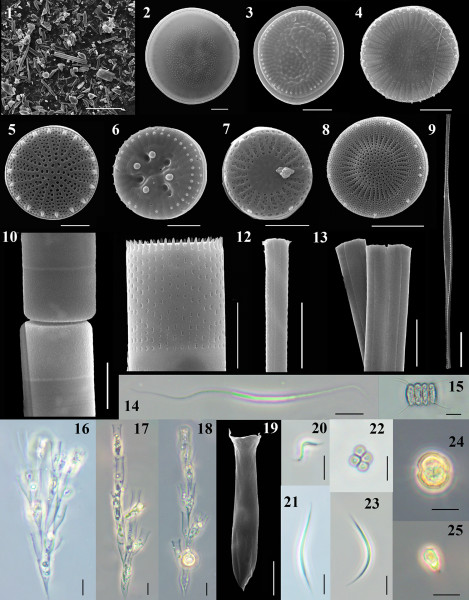Expedition along the rivers flowing into the Angara River
Within the RSF project “Microeukaryote Communities in Reservoirs of the Angara Cascade” (led by Ye.V. Likhoshway), an expedition trip was conducted on May 18, 2024 headed by Cand. Sc. (Biology) I.S. Mikhailov to collect samples at the mouths of small rivers flowing into the Angara River in order to determine their role in replenishing the diversity of phytoplankton of the Angara River. Drivers A.V. Rychkov (dropside UAZ K695AU) and F.A. Zamkovoy (Sobol H089KU) participated in the expedition, and I.N. Smolin assisted in sampling. Samples were taken at the mouths of the Irkut, Kuda, Kitoy, Belaya, and Ida rivers.
The pH and temperature in the water were measured using pH-410 (Aquilon, Russia). Samples were taken for hydrochemical analysis.
In the Angara River, water temperature varied from 4.8 °C (lower reach of the Irkutskaya HPP) to 8.3 °C (in front of the Belaya River). The highest water temperature was recorded in the Belaya River (14.6 °C) and the Irkut River (15.9 °C).
ВA high content of benthic diatoms was noted in the samples. Phytoplankton was mainly represented by diatoms, yellow-green algae, green microalgae, as well as cryptophytes and dinophytes. Preliminary data revealed that the phytoplankton of the rivers was dominated by diatom algae, which were represented by the species: Fragilaria radians (Kützing) D.M. Williams & Round, Ulnaria acus (Kützing) Aboal, Nitzschiа graciliformis Langre-Bertalot, Sinonsen et al., Cyclostephanos dubius (Hustedt) Round., Lindavia minuta (Skvortzov) T. Nakov et al., Aulacoseira islandica (O. Müller) Simonsen. Among the yellow-green algae, light microscopy revealed a diversity of algae belonging to the genus Dinobryon (D. divergens O.E. Imhof, Dinobryon cylindricum O.E. Imhof, Dinobryon cylindricum var. palustre Lemmermann и D. sociale (Ehrenberg) Ehrenberg. The green algae were represented by the species: Ankistrodesmus arcuatus Korshikov, Monoraphidium contortum (Thuret) Komárková-Legnerová, Desmodesmus communis (E. Hegewald) E. Hegewald и Sphaerocystis sp. Among the cryptophytes Rhodomonas pusilla (Bachmann) Javornický was found to be more common. Fragilaria radians, Ulnaria acus, were in first place in most of the studied rivers, as well as in the lower reach, and only in the Irkut River Nitzschiа graciliformis and small centric diatoms dominated, green algae Sphaerocystis sp. and species of the genus Desmodesmuswere also more common here. Electron microscopy data showed a large number of small centric diatoms, among which Stephanodiscus minutulus (Kützing) Cleve & Möller, predominated, and Discostella pseudostelligera (Hustedt) Houk & Klee, Pantocsekiella ocellata (Pantocsek) K.T. Kiss & Ács were also common. Preliminary sample analysis by electron microscopy (LEM and TEM) detected more than 50 species of chrychsophyte scales in the studied rivers. In two rivers, Irkut and Belaya, their species diversity reached 17 and 24 species, respectively. In the Belaya River, scaly chrysophytes collected on the filter were the dominant group; rare species were found. After the analysis is completed, an article will be prepared on the materials for the river phytoplankton research.
Microscopic analysis was carried out by senior researchers Cand. Sc. (Biology) A.D. Firsova and Cand. Sc. (Biology) A.Yu. Bessudova.

Представители фитопланктона исследованных рек:
1 – general plan of sampling from the Irkut River; 2 – Lindavia baicalensis (Skvortsov & K.I. Meyer) Nakov, Guillory, M.L. Julius, E.C. Theriot & A.J. Alverson; 3 – Lindavia minuta; 4 – Stephanocyclus meneghinianus (Kützing) Kulikovskiy, Genkal & Kociolek; 5 – Stephanodiscus minutulus; 6 – Pantocsekiella ocellata; 7 – Discostella pseudostelligera; 8 – Cyclostephanos dubius; 9 – Nitzschia graciliformis; 10 – Melosira varians C.Agardh; 11 – Aulacoseira islandica; 12 – Fragilaria radians; 13 – Ulnaria acus; 14 – Koliella longiseta (Vischer) Hindák; 15 – Desmodesmus communis (E.Hegewald) E.Hegewald; 16 – Dinobryon sociale; 17 – Dinobryon cylindricum var. palustre; 18 – Dinobryon divergens; 19 – Dinobryon cylindricum; 20 – Monoraphidium contortum; 21 – Monoraphidium griffithii; 22 – Lemmermannia komarekii (Hindák) C. Bock & Krienitz; 23 – Ankistrodesmus arcuatus; 24 – Glenodinium sp.; 25 – Rhodomonas pusilla. Scale bar: 1 – 100 µm.



